
Farley Boats set the standard along the Gulf Coast for fishing and sport from 1915 to the mid-1970s. Three generations of the Farley family designed and built the Farley Boat in the back of their home in Port Aransas, Texas.

Farley Boats set the standard along the Gulf Coast for fishing and sport from 1915 to the mid-1970s. Three generations of the Farley family designed and built the Farley Boat in the back of their home in Port Aransas, Texas.
In the early 1900s, tarpon fishing had begun to attract anglers from all across America to Port Aransas, Texas. However, because of the choppy waters, access to the Gulf Coast was severely restricted. The boats of the day were not designed or built to handle the rough Gulf Coast waters and storms in the early 1900s wiped out the existing charter fleet. The local guides and fishermen were desperate for boats. [1] [2]
Charles Frederick ("Fred") Farley, a master craftsman, was living in Birmingham, Alabama, when he learned from his brother that the guides of Port Aransas needed boats to satisfy the great demand for tarpon fishing. Fred traveled to the Gulf Coast with his three brothers where they designed and built utility boats, lighthouses, and ornate bars. Eventually, Fred settled down in Port Aransas, with his son and began designing and building boats. They established Farley and Son, Boat Builders, in 1915. [3]
Fred's earliest fishing boat design was an 18-footer built to meet the needs of local fishing guides. It was designed with low-sides and a high bow to fight the choppy waves. At that time, the only boats available to local anglers and guides were flat bottomed with high sides so they were not well equipped for the Gulf Coast chop. The Farley boat, on the other hand, was designed to fish the local waters and could handle the choppy water.
The earliest Farley Boats were 18 to 22 footers that carried two people. Later, the Farleys designed and built larger boats to accommodate more people and larger engines. The Farley Boats were known for a high chine that did not touch the water until well aft of the bow and a hatch in front of the windshield that opened. The Farley Boats were also designed with low cabins that allowed fishing in every direction.
Originally, Farley Boats were built with 5⁄8-inch-thick (16 mm) planks of top-grade cypress. They were light and very durable. After World War II, cypress became scarce and the Farley's switched to Honduran and Philippine mahogany.
The Farleys never drew up any official plans for the Farley Boats. Instead, they drew the design on the wood flooring of their shop. The Farleys marked the wood floors with a colored carpenters crayon and if prospective buyers wanted to see the boat plans, they would be shown the plywood. If the customer wanted to make a change to the boat design, the Farleys would whittle out a half-model of a boat.
Fred Farley's sons, Fred Farley Jr. and Jim Farley grew up building boats with their father and continued with the family business after Fred's death. After World War II, the boat works was moved to Mercer Street in Port Aransas, where it remained until around 1968 then moved to Avenue C. The Farley family designed and built Farley Boats until 1975.
Farley Boats were high quality boats and built to last. However, because of high frequency of hurricanes and the fact that no new models have been built in 40 years, there are very few remaining. Historians, anglers and boat builders are always on the lookout for Farley Boats. [4]
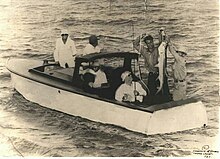
In 1936, President Franklin Delano Roosevelt visited Port Aransas, and was introduced to tarpon fishing. He enjoyed tarpon fishing so much that in 1937, while Congress was debating his Judiciary Reorganization Bill of 1937, he traveled to Port Aransas specifically to catch tarpon. [5] He hired Barney Farley, the famous fishing guide and brother of Fred Farley.
The president brought his own 35-foot fishing boat and Barney Farley agreed to take the President out on the boat. After an unsuccessful outing, Barney Farley convinced the president to fish from a Farley Boat. The President caught so many tarpon that he returned to Port Aransas later that year to again fish with Barney Farley on a Farley Boat. [6]
The current Farley Boat Company and the FDR fishing story is recounted in a 2012 episode of the syndicated television series Texas Country Reporter.
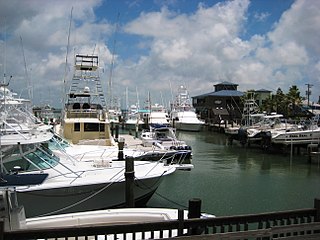
Port Aransas is a city in Nueces County, Texas, United States. This city is 180 miles southeast of San Antonio. The population was 2,904 at the 2020 census. Port Aransas is the only established town on Mustang Island. It is located north of Padre Island and is one of the longest barrier islands along the Texas coast. Corpus Christi Bay, the Gulf of Mexico, the Lydia Ann Ship Channel, and the Corpus Christi Ship Channel make up the surrounding waters.

Big-game fishing, also known as offshore sportfishing, offshore gamefishing or blue-water fishing, is a form of recreational fishing targeting large game fish, usually on a large body of water such as a sea or ocean.
Boca Grande is a small residential community on Gasparilla Island in southwest Florida. Gasparilla Island is a part of both Charlotte and Lee counties, while the actual village of Boca Grande, which is home to many seasonal and some year-round residents, is entirely in the Lee County portion of the island. It is part of the Cape Coral-Fort Myers, Florida Metropolitan Statistical Area. Boca Grande is known for its historic downtown, sugar sand beaches, blue water and world class fishing.

San Jose Island or San José Island is a barrier island on the Gulf Coast of Texas in the United States.

Aransas Bay is a bay on the Texas Gulf Coast, approximately 30 miles (48 km) northeast of Corpus Christi, and 173 miles (278 km) south of San Antonio. It is separated from the Gulf of Mexico by San José Island. Aransas Pass is the most direct navigable outlet into the Gulf of Mexico from the bay. The cities of Aransas Pass and Port Aransas are located at the southern end, and Rockport is found on the central western shore. The bay is oriented laterally northeast–southwest, and is extended by Redfish Bay to the southwest, Copano Bay to the west, Saint Charles Bay to the north, and Mesquite Bay to the northeast. Aransas Bay is part of the Mission-Aransas National Estuarine Research Reserve.
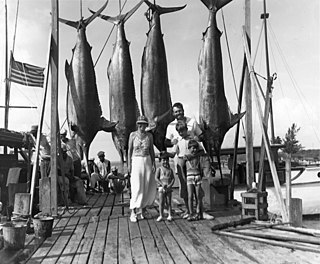
Marlin fishing or billfishing is offshore saltwater game fishing targeting several species of fast-swimming pelagic predatory fish with elongated rostrum collectively known as billfish, which include those from the families Istiophoridae and Xiphiidae (swordfish). It is considered by some fishermen to be a pinnacle of big-game fishing, due to the size, speed and power of the billfish and their relative elusiveness.
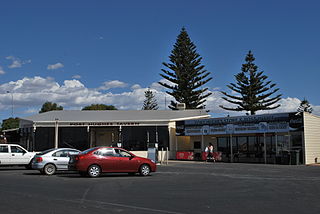
Port Hughes is a town and locality in the Australian state of South Australia located on northern Yorke Peninsula about 135 kilometres (84 mi) north-west of the state capital of Adelaide. It is considered part of the Moonta urban area by the Australian Bureau of Statistics. At the 2016 census, Port Hughes had a population of 571.

The Atlantic tarpon is a ray-finned fish that inhabits coastal waters, estuaries, lagoons, and rivers. It is also known as the silver king. It is found in the Atlantic Ocean, typically in tropical and subtropical regions, though it has been reported as far north as Nova Scotia and the Atlantic coast of southern France, and as far south as Argentina. As with all elopiformes, it spawns at sea. Its diet includes small fish and crustaceans.

Kayak fishing is fishing from a kayak. The kayak has long been a means of transportation and a means of accessing fishing grounds. Kayak fishing has gained popularity in recent times.

Alabama has a rich history and diversity of freshwater and saltwater sport fishing opportunities within its extensive rivers systems, farm ponds and the inshore and offshore saltwater of the Gulf of Mexico., The Bass Angler's Sportsman Society (B.A.S.S.), the leading promoter of competitive bass fishing was founded by Ray Scott in 1967 in Montgomery, Alabama. Alabama hosts numerous local, regional and national fishing tournaments every year.
Alabama supports 11 million angler fishing days with expenditures of three-quarters of a billion dollars, so join in the fun!
Fishing in Angola is mainly performed by foreign fleets. Some of the foreign fishing fleets operating in Angolan waters were required by the government to land a portion of their catch at Angolan ports to increase the local supply of fish. Fishing agreements of this kind were reached with several countries, including with Spain, Japan, and Italy.

The Tarpon Inn is a historic hotel located in Port Aransas, Texas, United States that originally opened in 1886. The building was named after the tarpon sport fish that drew many anglers to the sea side city and Port Aransas was called Tarpon at the time. The building was added to the National Register of Historic Places on September 14, 1979.
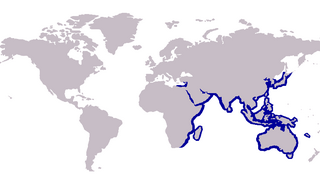
Smelt-whiting is the common name for various species of the family Sillaginidae. The Sillaginidae are distributed throughout the Indo-Pacific region, ranging from the west coast of Africa to Japan and Taiwan in the east, as well occupying as a number of small islands including New Caledonia in the Pacific Ocean. Well known members of this family include King George whiting, Japanese whiting, northern whiting, sand whiting and school whiting.

Porgy is the common name in Australia for any fish which belongs to the family Sparidae. They are also called bream. Porgies live in shallow temperate marine waters and are bottom-dwelling carnivores. Most species possess grinding, molar-like teeth. They are often good eating fish, particularly the gilt-head bream and the dentex.

Tarpon are fish of the genus Megalops. They are the only members of the family Megalopidae. Of the two species, one is native to the Atlantic, and the other to the Indo-Pacific Oceans.
The Mission-Aransas National Estuarine Research Reserve is a large contiguous complex of wetland, terrestrial, and marine environments on the Texas Coastal Bend in the United States. Named for the two major rivers that flow into the area, the reserve contains public and private lands and waters. The land is primarily coastal prairie with unique oak motte habitats. The wetlands include riparian habitat, freshwater marshes, and saltwater marshes. Within the water areas, the bays are large, open, and include extensive tidal flats, seagrass meadows, mangroves, and oyster reefs. These unique and diverse estuarine habitats in the western Gulf of Mexico support a host of endangered and threatened species including the endangered whooping crane.

Redfish Bay is a southwestern extension of Aransas Bay in Texas, north of Corpus Christi Bay. It separates the cities of Aransas Pass and Ingleside from Port Aransas on Mustang Island.

Excelsior is an authentically restored fishing smack of the Lowestoft fishing fleet and a member of the National Historic Fleet. She was built by John Chambers of Lowestoft in 1921 and worked until 1936 before being converted into a motor coaster.

A tube fly is a general tying style of artificial fly used by fly anglers. Tube flies differ from traditional artificial flies as they are tied on small diameter tubes, not hooks. Tube flies were originated in Aberdeen, Scotland by fly-dresser Minnie Morawski for Atlantic salmon anglers around 1945. Tube flies were designed to improve hooking success and to prevent damage to complex and expensive salmon flies by the teeth of hooked salmon. Tube flies have been widely adapted to fly patterns for a variety of cold water and warm water species and are extremely popular for steelhead and salmon in the Pacific Northwest and northeast United States, as well as saltwater species along the Atlantic, Florida and Gulf Coasts. They are widely used in European waters for Atlantic salmon, sea trout and pike.

The maritime industries of Taiwan are a large part of Taiwan's economy. Industries of particular importance are shipbuilding, boat building, maritime transport, aquaculture, mariculture, commercial fishing, seafood processing, offshore wind power and various forms of tourism. Deep sea mining, especially of dormant hydrothermal vents, is also being considered for the future. In 2018 Taiwan was the fourth largest yacht building nation. Taiwan is home to a number of maritime museums and maritime colleges.